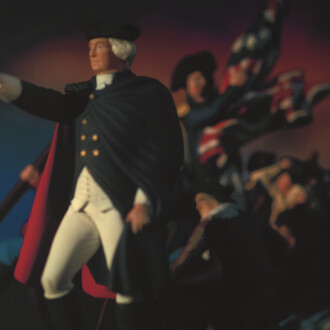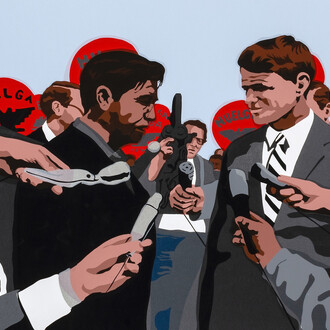In the autumn of 2018, the museum will examine its own history during the Second World War and the period immediately thereafter. A multifaceted exhibition and a new publication in the ‘Boijmans Studies’ series will examine the wartime activities of Museum Boymans, as it was then known, paying particular attention to the role of the museum’s director, Dirk Hannema, and the circle of collectors and patrons around the museum.
Following the devastating bombing of Rotterdam in May 1940, Hannema emerged as a defender of the city’s cultural heritage and a champion of contemporary art in the city. Under his leadership, the museum even managed to acquire countless artworks during these difficult years and organise a series of well-attended exhibitions. An ambitious museum director, Hannema enthusiastically adapted to the new occupying regime, which resulted in his being dismissed following the Liberation as a collaborator.
The exhibition will coincide with the publication of a scholarly biography of Hannema by Prof. Dr Wessel Krul and the completion of the museum’s own provenance research. This latter aspect will also be explored in the exhibition and the Boijmans Study. Are there works in the collection that may be considered looted art or which have a dubious provenance? When the Nazis came to power in Germany in 1933, they persecuted the Jews and confiscated their property. This led to large-scale looting of art collections prior to and during the Second World War, in which artworks were confiscated or the owners were forced to sell them for low prices.
The 1930s were the years in which Museum Boymans, as it was then known, blossomed. We meet the ambitious Dirk Hannema, director of the museum from 1921 to 1945, who turned the once provincial museum into a world-class venue, supported in his efforts by patrons such as D.G. van Beuningen and Willem van der Vorm. In 1935, the museum opened its new building, designed to show recently acquired masterpieces such as The Pedlar by Hieronymus Bosch in all their splendour. It was the period of the first blockbuster exhibitions of Vermeer, Bosch and Saenredam. The museum’s growth was temporarily interrupted by the outbreak of the war in September 1939 and the subsequent Nazi occupation of the Netherlands in May 1940.
Almost immediately following the dramatic bombing on 14 May 1940, Hannema dedicated himself to protecting Rotterdam’s cultural heritage and, despite the hardships, to stimulating the city’s art life. The collection, part of which had been secured in the museum’s cellars during the mobilisation of the Dutch army in August 1939, was now moved to safety. Partly at Hannema’s initiative, teams of workers roamed the city centre salvaging historical building fragments and tiles from the rubble. Many of Rotterdam’s artists lost their studios in the bombing. Hannema responded by commissioning them to depict the ravaged city.
During the years of the occupation, the museum was, to a certain extent, able to carry on its work ‘as usual’. Under Hannema’s leadership, the museum acquired numerous artworks and organised a series of well-attended exhibitions. Visitors to ‘Boijmans in the War’ will gain an insight into how Hannema and the museum struck a balance between artistic independence and the wishes of the Nazis. The exhibition highlights the difficult questions Hannema faced. To what extent do you dilute your vision in order to keep the museum open? Can you still organise exhibitions under the conditions set by the occupier? Is it important to remain active in such a situation or should you retreat?
The ambitious Hannema proved to be remarkably compliant with the new regime’s wishes and cooperated enthusiastically with its initiatives. But he also worked hard on behalf of Jewish and non-Jewish artists and collectors, some of whom he helped to get released. Nonetheless, after the Liberation he was charged with collaboration and dismissed as director. The exhibition coincides with the publication of a scholarly biography of Hannema by Wessel Krul, emeritus professor of the history of art at the University of Groningen, published by Prometheus.
The exhibition is accompanied by the latest in the series of Boijmans Studies, ‘A Controversial Past: Museum Boijmans Van Beuningen and the Second World War’ by Dr Ariëtte Dekker. The publication aims to provide transparency about the museum’s history during and after the Second World War. Dekker is a business economist and is the author of De Club Rotterdam (2008) and a biography of Anton Kröller (2015). The Boijmans Study sheds light on the role of Dirk Hannema and the museum’s important patrons, such as Franz W. Koenigs, D.G. van Beuningen and Willem van der Vorm, before, during and after the war.
The exhibition explores the various positions taken by artists in the city: artistic, political and in some cases an inevitable combination of the two. Artists who wished to continue to exhibit had to join the Kultuurkamer, an institution established by the Nazis. Many joined, but many refused – especially sculptors – and some artists joined the resistance, while others simply retreated to their studios and shut themselves away from the outside world.
Everyone had to adapt to the new situation. Questions around opportunism, naivety and different moral standpoints played a role and are raised in the exhibition. What is your role as an artist? When are you free to do as you wish? How principled can you be and still earn a living? The exhibition features works by Rotterdam-based artists such as Dick Elffers, Kees Timmer, Herman Bieling, Henk Chabot and Wally Elenbaas, who were faced with these questions.
The exhibition and accompanying Boijmans Study coincides with the completion of the museum’s investigation as part of the nationwide research project Museum Acquisitions from 1933. The aim was establish whether the collection contained artworks with a problematic provenance. The investigation focused on works acquired after 1933 or which changed hands in the period 1933-45. When the Nazis came to power in Germany in 1933, they persecuted the Jews and confiscated their property or forced them to sell it for extremely low sums. This large-scale art theft occurred in Austria following the annexation in 1938 and in occupied France and the Netherlands. In this period, Dutch museums unknowingly acquired some stolen artworks via art dealers, auction houses or private collectors. In later years also, museums acquired works not knowing that they were stolen, confiscated or forcibly sold during the Second World War.
The investigation into the collection of Museum Boijmans Van Beuningen has resulted in the restitution of seven artworks. Several of these case studies are dealt with in a separate section in the exhibition. In consultation with the heirs, the restituted works are being exhibited together with visualisations of the stories of the families involved, the works’ provenance and the restitution process.













